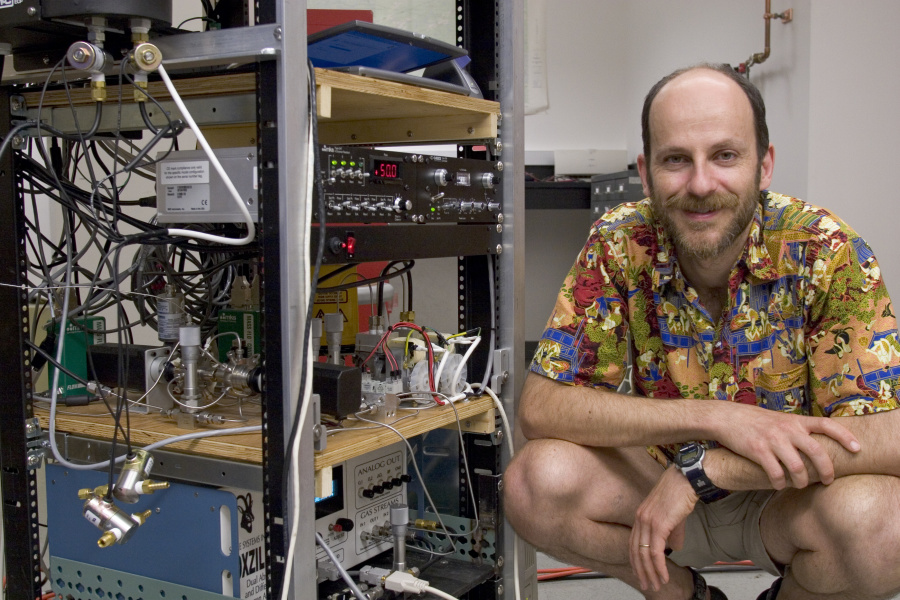Raine Raynor ’21 Adds Detail to the Global Oxygen Budget
By Rebecca Goldfine
In the worry over levels of carbon dioxide, Earth's oxygen budget sometimes gets overlooked. But oxygen, which makes up about eighty percent of the atmosphere, has been falling as carbon dioxide has been increasing (by much larger surges). Climate scientists are interested in watching both.
But even when oxygen gets its turn in the spotlight, carbon remains the star. "The reason we study oxygen is not because of its direct impact," explained Professor of Physics Mark Battle. "It's because it's a uniquely powerful diagnostic tool for carbon dioxide. When you learn about oxygen, you're learning about aspects of the carbon cycle that you can't understand any other way."
This summer, junior Raine Raynor has been calculating an additional factor that might be affecting Earth's oxygen levels. She is being advised by Battle.
With funding from an E. O. LaCasce Jr. Physics Fund Fellowship from Bowdoin, Raynor is looking at the extent to which industrial activities, such as the mining and processing of iron and steel, sulfur and sulfuric acid, aluminum, and copper, are consuming oxygen or releasing it into the air.

"I have been teaching myself about what happens during the mining and processing of these materials," she said. "I had to read up on equations and try to figure out what is happening."
Battle credits Raine with becoming so knowledgeable about the chemical reactions of mining processes that she has been able to educate him. "It's been really exciting, partly because when you come in knowing nothing about a topic, there's so much joy of discovery right away," he added.
And though she's been doing more chemistry than physics—which is her major, along with philosophy—Raynor, too, has enjoyed the process. "I think it is very exciting when I can draw all the pieces together and come to a conclusion," she said.
Completing the Oxygen Picture
Raynor's project is looking at a small component of the huge fluxes of carbon and oxygen—natural and human-caused, short- and long-term—that researchers are tracking across oceans and lands, and in the atmosphere. While in totality this is a massive phenomenon, every single piece of data helps to refine scientists' understanding of the global carbon cycle.
In the last twenty-five years, the field of climate science focused on atmospheric oxygen has advanced so much it is able to look at increasingly detailed data. "All the big picture issues have been resolved, and we're starting to tidy up the loose ends," Battle said, which is where Raynor's project comes in. "If we want to say we've left no stone unturned, we need to look at the industrial processing of the largest-scale minerals."
After a couple months of work, Raynor's calculations show a surprising result. While the processing of sulfur ore and sulfuric acid creates a straightforward oxygen sink from the atmosphere, the refining of iron ore, steel, and copper also releases carbon dioxide. Meanwhile, aluminum refining emits carbon dioxide without any effect on atmospheric oxygen budgets, Raynor explained.
"The amount of CO2 released by iron, steel, aluminum, and copper is in the order of millions of tons of carbon dioxide," she continued. "However it is small enough in comparison to worldwide CO2 emissions related to fossil fuels that we suspect it might have negligible effects on the global carbon cycle and climate change."
A few technical details of Raynor's work (for those who love chemistry): "When you dig up iron, it's essentially oxidized, it's rusty," Battle explained. "If you want to turn iron into material for a bridge or rebar for a runway, you need to pry off the oxygen." So he and Raynor naively thought they would discover that the industrial processing of oxidized minerals—iron, sulphur, aluminum, and copper—would end up releasing oxygen into the atmosphere. What they learned instead is that the oxygen is attaching to carbon monoxide (which is produced in the fossil-fueled processing). "For example, you can take coal, burn it in an oxygen-poor environment, make lots of carbon monoxide, run that over iron to strip off the oxygen, and now you have carbon dioxide in the atmosphere. Instead of releasing oxygen directly to the atmosphere, it’s being bound up as carbon dioxide which is then released," Battle said.



